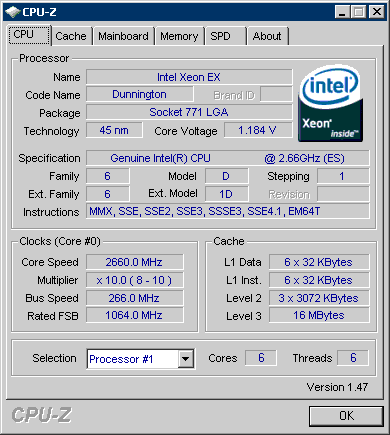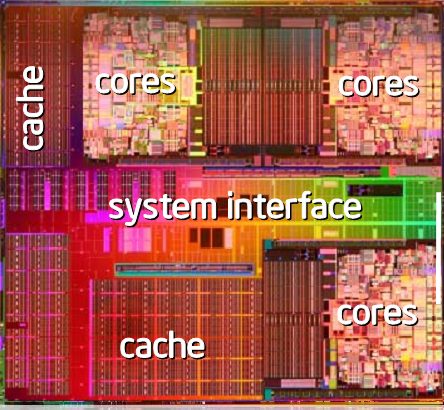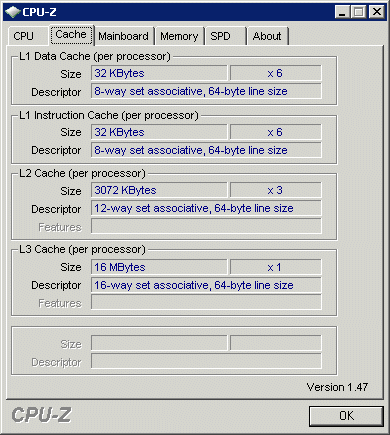Intel Xeon 7460: Six Cores to Bulldoze Opteron
by Johan De Gelas on September 23, 2008 12:00 AM EST- Posted in
- IT Computing
The upcoming Intel Nehalem CPU has been in the spotlight for months now. In contrast and despite the huge die size and 1.9 billion (!) transistors, the 6-core Xeon 74xx is a wallflower for both the public as Intel's marketing. However, if you've invested in the current Intel platform, the newly launched Intel 74xx series deserves a lot more attention.
The Xeon 74xx, formerly known as Dunnington, is indeed a very interesting upgrade path for the older quad socket platform. All Xeon 74xx use the same mPGA604 socket as previous Xeons and are electrically compatible with the Xeon 73xx series. The Xeon 73xx , also known as Tigerton, was basically the quad-core version of the Xeon 53xx (Clovertown) that launched at the end 2006. The new hex-core Dunnington combines six of the latest 45nm Xeon Penryn cores on a single die. As you may remember from our dual socket 45nm Xeon 54xx review, the 45nm Penryn core is about 10% to 20% faster than its older 65nm brother (Merom). There is more: an enormous 12MB to 16MB L3 cache ensures that those six cores access high latency main memory a lot less. This huge L3 also reduces the amount of "cache syncing" traffic between the CPUs, an important bottleneck for the current Intel server platforms.

2.66GHz, 6 cores, 3x3MB L2, and 16MB L3 cache: a massive new Intel CPU
With at least 10% to 20% better performance per core, two extra cores per CPU package, and an upgrade that only requires a BIOS update, the newest Xeon 7460 should be an attractive proposal if you are short on processing power.
Six Cores?
Dunnington was announced at the past IDFs as "extending the MP leadership". Readers who read our last quad socket report understand that this is a questionable claim. Since AMD introduced the Opteron 8xxx in April 2003, there has never been a moment that Intel was able to lead the dance in the quad socket server market. Sure, the Intel 73xx was able to outperform the AMD chip in some areas (rendering), but the AMD quad-core was still able to keep up with Intel chip in Java, ERP, and database performance. When it comes to HPC, the AMD chip was clearly in the lead.
Dunnington might not be the darling of Intel marketing, but the chip itself is a very aggressive statement: let us "Bulldoze" AMD out of the quad socket market with a truly gigantic chip that only Intel can produce without losing money. Intel is probably - courtesy of the impressive ultra low leakage 45nm high-K process technology - the only one capable of producing large quantities of CPUs containing 1.9 billion transistors, resulting in an enormous die size of 503 mm2. That is almost twice the size of AMD's upcoming 45nm quad-core CPU Shanghai. Even IBM's flagship POWER6 processor (up to 4.7GHz) is only 341 mm2 and only has 790 million transistors.
| Processor Size and Technology Comparison | ||||
| CPU | transistors count (million) | Process | Die Size | Cores |
| Intel Dunnington | 1900 | 45 nm | 503 | 6 |
| Intel Nehalem | 731 | 45 nm | 265 | 4 |
| AMD Shanghai | 705 | 45 nm | 263 | 4 |
| AMD Barcelona | 463 | 65 nm | 283 | 4 |
| Intel Tigerton | 2 x 291 = 582 | 65 nm | 2 x 143 = 286 | 4 |
| Intel Harpertown | 2 x 410 = 820 | 45 nm | 2 x 107 = 214 | 4 |
The huge, somewhat irregular die - notice how the two cores in the top right corner are further away from the L3 cache than the other four - raises some questions. Such an irregular die could introduce extra wire delays, reducing the clock speed somewhat. Why did Intel not choose to go for an 8-core design? The basic explanation that Patrick Gelsinger, General Manager of Intel's Digital Enterprise Group, gave was that simulations showed that a 6-core with 16MB L3 outperformed 8-core with a smaller L3 in the applications that matter the most in the 4S/8S socket space.

Layout of the new hex-core
TDP was probably the most important constraint that determined the choice of six cores, since core logic consumes a lot more power than cache. An 8-core design would make it necessary to reduce the clock speed too much. Even at 65nm, Intel was already capable of producing caches that needed less than 1W/MB, so we can assume that the 16MB cache consumes around 16W or less. That leaves more than 100W for the six cores, which allows decent clock speeds at very acceptable TDPs as you can see in the table below.
| Processor Speed and Cache Comparison | |||||
| Xeon model | Speed (GHz) | Cores | L2 Cache (MB) | L3 Cache (MB) | TDP (W) |
| X7460 | 2.66 | 6 | 3x3 | 16 | 130 |
| E7450 | 2.4 | 6 | 3x3 | 12 | 90 |
| X7350 | 2.93 | 4 | 2x4 | 0 | 130 |
| E7440 | 2.4 | 4 | 2x3 | 12 | 90 |
| E7340 | 2.4 | 4 | 2x4 | 0 | 80 |
| E7330 | 2.4 | 4 | 2x4 | 0 | 80 |
| E7430 | 2.13 | 4 | 2x3 | 12 | 90 |
| E7420 | 2.13 | 4 | 2x3 | 8 | 90 |
| L7455 | 2.13 | 6 | 3x3 | 12 | 65 |
| L7445 | 2.13 | 4 | 2x3 | 12 | 50 |
The other side of the coin is that Dunnington probably uses an L3 cache that runs at half the clock speed of the cores. We recorded a 103 cycle latency, measured with a 2.66GHz CPU (39 ns), for the L3 cache.

Dunnington cache hierarchy
In comparison, the - admittedly much smaller - L3 cache of the quad-core Opteron needs 48 cycles (using a 2.5GHz chip, or 19 ns). The L3 cache is about half as fast as the one found in the Barcelona core, so the L3 is a compromise where the engineers traded in speed for size and power consumption.










34 Comments
View All Comments
JarredWalton - Wednesday, September 24, 2008 - link
I'm sure Johan will rerun tests when Shanghai actually launches. He's been working on creating the virtualization testing scenarios for a while, and with something finally in place testing of future products will not be a problem. The launch of Dunnington just happened to coincide with the time for doing this virtualization article.helldrell666 - Wednesday, September 24, 2008 - link
It seems that inquirer's Charlie demirjian was right after all,Anandtch is a pro INTEL anti AMD sight.It's obvious that their reviews are biased and unfair against AMD.Anandtech exists to troll for INTEL...That's it.
Loknar - Wednesday, September 24, 2008 - link
Years ago the Inquirer accused Anandtech of being pro-AMD. Check out the old Athlon XP articles. I won't let you accuse Anandtech of being biased! This is one of the only smart website in the world, please look in your own backyard before accusing the only ones doing true reporting.Anyway.. what is this about AMD vs Intel? We are enthusiastically watching the competitors fighting each other in the most healthy way. Did you buy AMD stocks or - why do you seem to have personal interest in this matter?
Chill out and enjoy the nice products this competition brings is what I'm saying.
whatthehey - Wednesday, September 24, 2008 - link
Anyone who ever - EVER - refers to someone form the Inquirer as being "right" is so obviously stupid that you don't even deserve to read articles like this. All you'll do is hurt your tiny little brain trying to fit truth into your world-view where AMD rules, Intel sucks, and Charlie isn't an idiot.FWIW, I read this article and didn't feel it was at all Intel biased. We all know that AMD can't compete worth a damn on the desktop, and AnandTech has been one of the few sites that has provided any serious server articles where they have frequently pointed out performance advantages AMD still maintains. Even this article is quite positive for AMD, showing that many IT admins with Opteron servers should be fine for a while yet. If you're buying a new server, Dunnington appears to (finally) take the performance crown for 4S/8S and virtualization servers. I also understand how complex coming up with anything resembling a repeatable virtualization benchmark, so it's nice to see some independent testing that doesn't end up praising blade farms. Not that there's anything wrong with blades... other than the proprietary nature and extremely high costs.
socrilles07 - Wednesday, September 24, 2008 - link
I don't get it - instead of using the already released high end AMD processor they used the much lower price point processor for a quite unfair comparison. In the end they make assumptions about what the performance to watt will be in the higher end processor. I thought anandtech was suppose to be THE review site, can you not afford the faster processor? or has AMD stopped providing you samples because of you bias? Lets do Apples to Apples comparisonsJohanAnandtech - Wednesday, September 24, 2008 - link
Add 8% to our 8356 benchmarks and you'll know where the AMD Opteron 8360SE ends up in the best case. It is not that hard.From price/performance/Watt point of view, the 8356 is the best offer AMD has right now, and I am sure AMD would sent us another CPU if they felt otherwise.
We can not buy CPUs at $2000 a piece for each review that we write. If you work with virtualization and other server software, you have an idea how many manhours go in this kind of article. Add $8000 of AMD CPUs, $8000 of Intel CPUs... I hope you understand I don't feel like spending the rest of my time on ebay desperately trying to recoup some of my massive losses of buying server CPUs.
socrilles07 - Wednesday, September 24, 2008 - link
you can't buy processors that cost $2000 a piece but some how you manage to get samples of processors costing twice that before they are released......so obviously you are no longer getting samples from AMD for some reason if not you could've done a comparison with at least the high end processor if not the next gen AMD processor which wouldve been more like the anandtech of the past.JohanAnandtech - Wednesday, September 24, 2008 - link
"so obviously you are no longer getting samples from AMD for some reason"We'll see. :-)
helldrell666 - Tuesday, September 23, 2008 - link
What a good INTEL supporting article.But, It is expected from anandetch.Their ATOM review that made ATOM look like the best offering in it's category and their phenom reviews that made the phenom look like a two dual cores on a chip with one disabled.....These days one must take every little thing with a lot of salt.Bulldoze.....!!!!
Anantech reviews of AMD's products are stuffed with false and biased perspectives and numbers.
npp - Tuesday, September 23, 2008 - link
Look, we're trying to get some discussion here. If you don't like anandtech and you're convinced that it is biased towards Intel, why do you keep reading it? And if you've expected that a six-core Intel CPU would be slower than an AMD quad-core, you were obvoiusly mistaken, so take a note and give some constructive criticism, if you can.